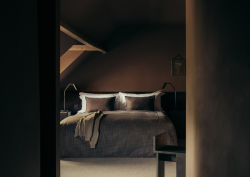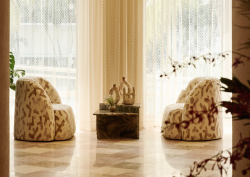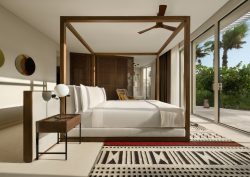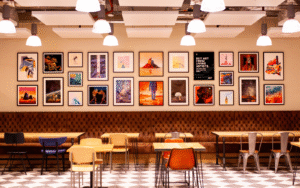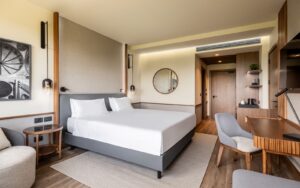In the heart of Seville, the iconic Hotel Colón Gran Meliá re-emerges from lockdown showcasing a sophisticated first impression that’s timeless design effortlessly takes it into a new era. Editor Hamish Kilburn is among those ‘first in’ to explore the newly renovated hotel – and while there, he manages to secure an interview with the interior designer behind the project…

With its grandeur monuments, orange tree-lined cobbled streets and a vibrant gastronomy scene, Seville is a city that will leave a lasting impression on even the most seasoned of travellers. At the epicentre of this cultural hub – just a 10-minute stroll from the The río Guadalquivir, the Torre del Oro and the Real Maestranza Bull Ring – is Hotel Colón Gran Meliá; a hotel that has been an inherent part of Seville since its iconic architecture by José Miguel de la Cuadra was first unveiled in 1929.
Some 92 years later, and the building is now a listed pillar, having majestically maintained its original neoclassical façade. Don’t let its grand structure fool you, though. It shelters a contemporary hotel that fluidly forms around a modernist central dome, made up of thousands of coloured crystals. It, as Rosana Gonzáles, General Manager of the hotel says: “Shines over the hotel bringing a new light over Seville’s history.” And it was this central part of the hotel that became the core inspiration for interior designer Álvaro Sans when he was asked to steer to the its public areas through a sensitive renovation that could meet the demands of today’s travellers.
“Seville is a unique city, the ‘Spanish Florence’, if you like.” – Álvaro Sans, interior designer.

Image caption: The central dome inside Gran Melia Hotel Colón, which is the heart of the hotel and was a significant source of inspiration for the design team. | Image credit: Meliá Hotels International
“We wanted to differentiate Hotel Colón Gran Meliá from the rest of the hotels in the city,” said Sans. “To do this, we decided to inject a healthy dose of Sevillian culture, art and feeling into the building. The strong sense of place transports guests to the destination where they can really experience the true essence of the location. Seville is a unique city, the ‘Spanish Florence’, if you like. The ‘Sevillano’ is felt in the streets and by visitors who live who live within it. There is a contagious joy of living here.”
QUICK-FIRE ROUND WITH THE DESIGNER:
Hamish Kilburn: How long did the project take from concept to completion?
Álvaro Sans: Two years, due to delays with Covid-19
HK: Describe the newly renovated hotel in two words?
AS: Sevillian and timeless
HK: What’s next for the hotel?
AS: Two wonderful suites, but you didn’t hear that from me!
There is no doubt about it: the hotel’s rejuvenation has been influenced by the past. However, its hospitality offering on the other hand has been created with a worldly traveller in mind, while looking ahead towards the future. By opening up the space in the lobby, the opportunity emerged for Sans to create a new F&B proposal – a new destination bar – that is now the focal point of all first impressions, which sits under the magnificent dome. The interiors of the bar are decorated with pieces that have been curated by young local artisans. Together, they form a magical atmosphere.
Making such a drastic transformation in an iconic hotel is challenging enough, but add to this the fact that Sans was working on this project during a pandemic creates a whole new layer of uncertainty. “The delivery times of materials was a great task to manage,” Sans explains. “We had to change some furniture items because they did not arrive after five months of delay.”
Originally known as Hotel Majestic, the property was, in its hay day, one of the most luxurious hotels in Spain, built primarily to welcome international visitors of the world’s fair, Exposición Iberoamericana, hosted in Seville in 1929. Following this, world renowned figures such as Ava Gardner, Picasso and Dalí also walked its floors and fell in love with the historical building. The hotel was where famous matadors (bull fighters) used to stay ahead of crowd-drawing Corridas (bull fighting events), which arguably helped put Seville on the tourism – domestic and international – map. In fact, traje de luces (the various costumes) of the famous El Cordobes have become part of the interior design decoration, displayed behind the check-in desk, along with original flamenco dancer costumes, to add a unique sense of place for guests who are beginning or ending their stay.

Image caption: The check-in desk inside the hotel features a display of memorabilia, which gives a sensitive nod to Sevillian culture. | Image credit: Melia Hotels International
As guests arrive, what was a dated red and white design scheme has been transformed into a space that feels light, elegant and welcoming. “Pure red is a colour only used in the bullfighter’s cape in Seville – it is not an emblematic colour of the city,” explains the designer. The lobby now features hues of green, ochra, gold – reminiscent of the Andalusian countryside. Wood alongside luxurious and elegant materials such as velvet, silk, leather and walnut add meaningful texture. Amongst the new services, guests can enjoy a completely new Red Level on the ground floor, the new Bar del Colón and the restaurant Abacería del Colón.
“Seville is olive green,” adds Sans. “It is a city with many cultures that have merged in a magnificent way. The hotel, therefore, had to have something that amplified this authentically.” To achieve this, Sans introduced natural materials – Andalusian Macael white marble, solid walnut wood, hydraulic concrete floors – designed and built for the hotel, in a format larger than the traditional one. “We chose olive green [throughout the lobby and public areas downstairs], to mimic hotel’s wonderful skylight,” says Sans. “Ceramics were handcrafted specially for the hotel by Isabel Parente’s workshop in Seville, in an oxidised olive-green tone and an original Mudejar design, with details of the plasterwork from the Alhambra in Granada.”
-

- Image caption: The design of the F&B area inside the hotel continues the cohesive design narrative from the lobby. | Image credit: Meliá International
-

- Image caption: The new design of the lobby opened up space for a new F&B outlet to emerge. | Image credit: Meliá International
One of the gastronomy venues at the hotel, Burladero restaurant offers a wide range of Andalucian tapas that attract locals as well as international visitors. The new Abacería del Colón is a place where guests can indulge in typical Sevillan produce such as jamón, cold meats, jams and chicharrones, as well as purchasing them to bring that iconic Sevillian flavour back home.
The hotel is also part of the Virtuoso y Fine Hotels and Resorts de Amex (FHR), as well as The Leading Hotels Of The World (LHW). It comprises of 188 rooms including 24 suites, adorned with classic paintings of the Spanish Golden Age from artists such as Goya, Murillo, Velazquez y and El Greco – the giants of 16th and 17th century Spanish painting.

Image caption: If rumours are to be believed, the next chapter for the hotel will be the renovation of two suites. | Image credit: Meliá International
The newly renovated Hotel Colón Gran Meliá is a tribute to Seville’s history and culture; a space where old and new meet with incredible results. Everything is curated to the smallest detail and recalls original elements from the 1929 Exposition to make every guest walk back in the past and discover the beauty of the city. And with whispers all but confirmed from Meliá International that the hotel will unveil two new renovated suites soon, it’s clear that the Gran Melia Hotel Colón’s narrative is far from ending.
Main image credit: Meliá International





